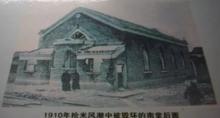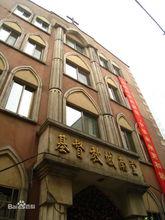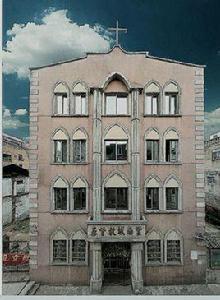教堂動態
名冊登記
教別:基督教。
場所類別:教堂。
登記名稱:基督教城南堂。
場所地址:天心區社壇街56號。
登記發證部門及編號:湘J010020001。
填報單位:天心區民族宗教和外事僑務局。
文明建設
為創建“四型”(文化型、學習型、道德型、生態型)宗教活動場所,從2015年起,基督教城南堂被長沙市民族宗教事務局,選定為“道德型”示範點。
聚會時間
| 日期 | 時間 | 主題 | 位置 |
| 周日 | 上午7:30 | 第一堂主日崇拜 | 主堂二樓;副堂(板房) |
| 第一堂慕道班 | 主堂一樓 | ||
| 上午9:00 | 第二堂主日崇拜 | 主堂二樓;副堂(板房) | |
| 第二堂慕道班 | 主堂一樓 | ||
| 心理輔導班 | (院內東南角)板房二樓 | ||
| 兒童班 | (院內東北方)主日學班 | ||
| 上午10:30 | 第三堂主日崇拜 | 主堂二樓;副堂(板房) | |
| 周二 | 上午8:30 | 禱告聚會 | |
| 上午9:10 | 解經聚會 | ||
| 晚上19:10 | 中年聚會 | 主堂二樓 | |
| 周三 | 晚上19:30 | 青年聚會 | 主堂二樓 |
| 周五 | 上午8:30 | 專題講座 | |
| 周六 | 下午13:00 | 英語查經 | 副堂(板房)英語角。 註:外教休寒暑假,每到寒暑假,英語角停止聚會。 |
| 下午14:30 | 英語團契 |
教堂歷史
 110多年前的石碑依然屹立在城南堂的後院草坪
110多年前的石碑依然屹立在城南堂的後院草坪長沙市城南堂,前身為基督教中華內地會的教堂——福音堂,始建於 1907年(清光緒三十三年)。
內地會系中華基督教的一個教派,創始人為英國人戴德生牧師。戴於1865年在英國創立基督教內地會,正式加入組織負責會務的成員中有中、英、美、德、挪威等15國的傳教士。
1898年,內地會美籍葛蔭華博士來到長沙,在學院街組織小規模的布道工作;1902年,在學院街租房創建長沙內地會。
1905年6月1日,戴德生牧師來長沙內地會視察;2日,登南門城牆,遠眺麓山湘水,近望長沙全城,心潮起伏,感慨叢生;6月3日上午講道,下午參加茶會,返家上樓臥床休息、閱書信,無疾而終,歸主懷中。
1907年,德國博士何倫衛、顧蒙恩,在長沙社壇街購地,建內地會福音堂及住宅三棟。
1909年,美、德兩個內地會協商,將學院街內地會與社壇街德國內地會合併;1923年,由差會派德籍安德醫生來長沙創辦醫院,遂將學院街房屋全部作為醫院之用,改名為德生醫院,以紀念內地會創始人戴德生。
教堂曾兩次被搗毀,1910年長沙“搶米風潮”中教堂房屋焚毀,同年修復;1930年長沙內地會的房屋又被戰火焚毀,當年即修復,直到1949年。
 1910年槍米風潮中被毀壞的南堂後面
1910年槍米風潮中被毀壞的南堂後面1958年,為了打破宗派界限,長沙市十幾個不同宗派的教會實行聯合禮拜,社壇街內地會福音堂更名為中華基督教城南堂,為長沙市城南地區基督徒聚會禮拜的場所。1966年,受“文化大革命”的衝擊,教會停辦。城南堂的房屋被某些單位作為倉庫或車間使用。
1982年,經長沙市人民政府同意,城南堂作為宗教活動場所重新開放。經過認真落實黨的宗教政策,市房產局於1985年,將教堂交還給長沙市基督教三自愛國運動委員會管理,但由於長久失修,教堂房屋已成危房。市基督教兩會自籌人民幣20多萬元對之進行重建,經過兩年的努力,於1987年底竣工,1988年元月1日正式舉行復堂典禮。
 現在的長沙市基督教城南堂
現在的長沙市基督教城南堂Changsha South Church was found in 1907 from the Chinese Inland Mission Gospel Church (the 33rd year of Qing Emperor GuanXu).
The Chinese Inland Mission Church is a branch founded by a British pastor, Hudson Taylor, and was established in the UK in 1865. The Missionaries involved in the church’s formation came from 15 countries including: China, The United Kingdom, The United States of America, Germany, and Norway.
In 1898, American Pastor Dr. GeYinHua who was a member of the Chinese Inland Mission, came to Changsha and organized a small scaled work in XueYuan Street. Dr. GeYinHua rented a house to establish Changsha’s Inland Mission congregation in 1902.
Pastor Hudson Taylor came to Changsha’s Inland Mission congregation on June 1st 1905. The next day, he went to the South Gate of the City Wall to view YueLu mountain, the XiangJiang river, and to pray for the City and its people. On June 3rd he preached in the morning and attended a Tea Ceremony in the afternoon. Afterwards, returning home to rest and read letters, he died peacefully and entered to God’s arms.
In 1907, German Pastor Dr. HeLunWei and GuMengEn purchased a land in SheTan Street and established a Gospel Church, which included three apartments.
In 1909, the Gospel Church in SheTan Street and Inland Mission Congregation in XueYuan Street combined to form the Chinese Inland Mission Gospel Church. In 1923, an International Christian group sent German Dr. AnDe to Changsha to establish a hospital. He renovated all the apartments in XueYuan Street for hospital usages and named it in memory of Hudson Taylor.
 現在的長沙市基督教城南堂
現在的長沙市基督教城南堂The church was damaged by fire twice: firstly in 1910 during the Rice Revolution, but was restored that summer, and then in 1930, when the Church was burned during the war, but was again restored and suffered no further damage during war time until 1949.
In 1958 the Chinese Inland Mission Gospel Church, in order to break the boundaries of different denominations, combined with more than ten different Christian fellowships and changed its name to the Chinese Christian South Church. This became the place for Christians in the south of Changsha to worship God. In 1966, the church closed its doors due to The Culture Revolution and the building was occupied by some companies and used as warehouses or garages.
 現在的長沙市基督教城南堂
現在的長沙市基督教城南堂In 1982, by government approval, South Church reopened as a religious meeting place. After the establishment of the Communist Party’s religious policy in 1985, management was transferred to Changsha Three-Self Patriotic Movement Committee by the City Real Estate department. However, the church building hadn’t repair for many years and became desolated. Changsha Christian Board raised over 200,000RMB to restore the church and after two years’ of hard work the building was finally completed at the end of 1987. The building was officially re-opened on January 1st 1988.

